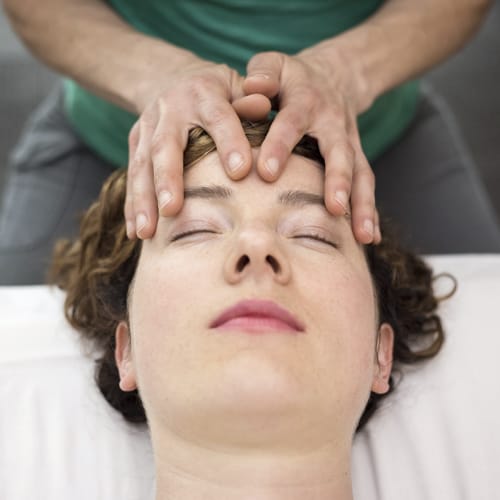What is Craniosacral Therapy?
Craniosacral therapy (CST) is a gentle modality that relaxes the body by releasing tension in the bones of the head, and the tissues in the brain, spinal cord and vertebral column. When parts of the craniosacral system are "stuck," strain can be placed on the nerves, veins and membranes in the central nervous system, which can cause symptoms in many areas or systems of the body. CST balances the central nervous system, allowing it to perform at its best; this encourages the body to self-correct, thus alleviating a surprising variety of symptoms.
Treatment of the Cranial Bones and the Dural Tube
Five grams of pressure- -the weight of a nickel--is used to coax the cranial bones away from each other. Once the bones can move more freely (these are minute movements), they can be used as levers to stretch the tissues within the cranium that attach to them. Some clients report feeling a sense of well-being with these maneuvers and most clients become so relaxed they fall asleep.
-the weight of a nickel--is used to coax the cranial bones away from each other. Once the bones can move more freely (these are minute movements), they can be used as levers to stretch the tissues within the cranium that attach to them. Some clients report feeling a sense of well-being with these maneuvers and most clients become so relaxed they fall asleep.
The dural tube is a continuation of the covering inside the skull and attaches to the sacrum at the base of the spine. It houses and protects the spinal cord. This tube can get "stuck" in various places along the spine. In CST, gentle techniques are used to release it, and most clients report a relaxing effect in their lower back, hamstrings and gluteals. Throughout the session, the therapist assesses the rhythm of the cerebrospinal fluid flow in both the head and other areas of the body. At some point in the session, this rhythm is brought to the "stillpoint"--that is, it appears to stop altogether. After a bit, it starts up again, more robust than before; this aspect of the treatment is believed to contribute greatly to its healing effect.
Treatment of the Sacrum
The final piece of the treatment is freeing and balancing the sacrum at the base of the spine. Very gentle techniques are performed to decompress it from the lumbar vertebrae above it, and encourage it to "float" away from the iliosacral joints on either side. This is important, because free, symmetrical movement between the sacrum and the occiput of the head ensures proper flow of the cerebrospinal fluid, which nourishes all the tissues in the central nervous system.
What Conditions Can CST help?
I have seen many clients benefit greatly from treatment. One of the most notable conditions that has responded well is concussions. Clients report feeling more clear-headed and having improved memory after as little as one treatment. Other clients have had relief from fibromyalgia, lower back pain, and sciatica (especially in conjunction with some myofascial release), as well as relief from debilitating headaches and anxiety. For some of my clients with very tight muscles, CST sessions have given them a more normal resting tone, and they have chosen to continue CST as their primary bodywork; others have found that after a few sessions of CST, deep tissue massage becomes much more comfortable and effective.
Below is a non-exhaustive list of dysfunctions that CST helps, according to the Upledger Institute:
- Migraines and headaches
- Chronic neck and back pain
- Stress and tension-related disorders
- Motor-Coordination Impairments
- Infant and childhood disorders (including torticollis)
- Spinal cord injuries
- Post-concussion symptoms
- Chronic fatigue
- Fibromyalgia
- TMJ syndrome
- Scoliosis
- Central nervous system disorders
- Learning disabilities
- ADD/ADHD
- Post-traumatic stress disorder
- Orthopedic problems
- Research is now being done on the benefits of CST on Parkinson's disease and Alzheimer's
Some clients may not want to give up a whole massage session to try a Craniosacral treatment, which is understandable! That's why I'm happy to combine elements of CST with massage; it can have profound effects even when the whole protocol isn't done. If you would like to give it a try, just let me know, and we can customize your session!


